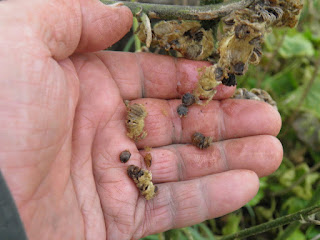THE DAYLILY DISPLAY GARDEN
A below zero morning with wind gusts in the 15-22 mph range. Not a nice day to travel as the wind is blowing the snow so hard that visibility at times is difficult. Just the same, memories of summer and gardens makes everything seem a great deal better. Here are some pictures of our daylily display garden from mid July when the daylilies were just beginning to look nice.
Years ago Gail hired a young college aged guy for a couple-three summers. This was when we were getting the flower farm set up and Austin got this daylily display garden started after Brien Ducharme layed out some incredible stones. Austin was like Alex, he had no fear of using a shovel and he planted a couple hundred clumps of daylilies to get us going. Now twelve years later the garden is still not what I want it to be but it's getting closer. It's certainly worth a look-see if you come to visit.
The garden now has well over 300 clumps of the +700 daylilies we raise and those daylilies have plenty of company. 20 varieties of astilbes (we grow 55 varieties) join 5 varieties of vernonia/ironweed and three varieties of veronicastrun which add some height. Ninebark Diabolo, some Dolgo crab apples, and half a dozen different dwarf conifers add to the mix. Hollyhocks in whites, dark reds, roses, and yellows are planted here and there. Garden phlox are coming along and should look great in 2019 in the company of butterfly weed, 400 liatris, helenium 'Salsa', a turtlehead name 'Hot Lips', and three varieties of monarda/bee balm. Jacob Cline, Raspberry Wine and Gardenview Scarlet. Jody and Michelle planted a couple bushels of daffodils this fall so they should catch your eye as you pass along Route 2 this spring.It's coming!
Gail is our authority on Hydrangea paniculata and she has this habit of laying out pots of new-to-us varieties she thinks will look nice incorporated with the daylilies. I'm the planter! Little Quickfire, Zinfin Doll, Invincibelle Wee White and Pillow Talk are some I remember planting this fall. There may be others. One thing is certain.... in 2019 this will be one very nice garden. Come visit!
George Africa
The Vermont Gardener
Vermont Flower Farm and Gardens
Marshfield Vermont








